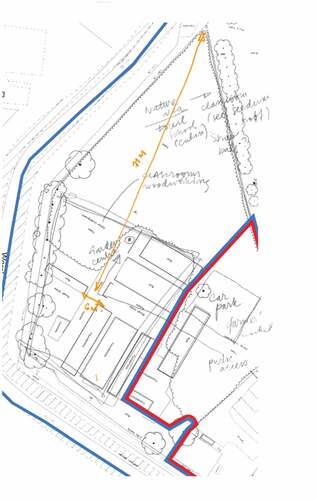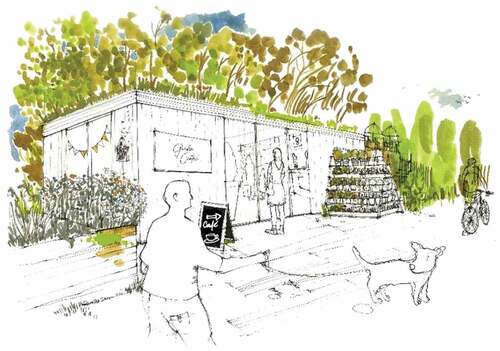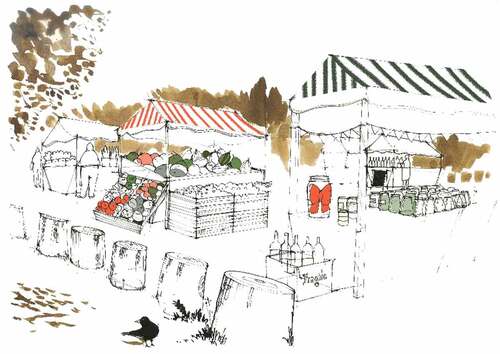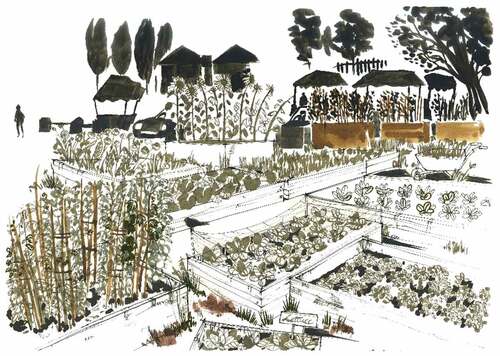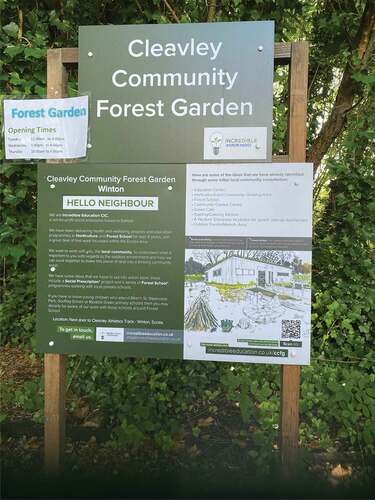Abstract
The green agenda is high on the list of priorities of local, national, and global governments. In the UK, a new £40 million scheme aims to encourage a sustainable recovery alongside policies—such as the 25 Year Environment Plan—and other tools pushing more investment into the area. With this push, we are now seeing innovation in urban green infrastructure: from pocket parks, to Americanised models of community gardens both becoming more frequent across our cityscapes. This paper critically explores the rise of “radical sustainability” and the need to embrace new forms of urban green infrastructure. The focus of the paper is explicitly on enabling urban food growing in cities. We begin with an overview of the practice before proceeding to review current policy tools and, finally, reflecting on a case study in Salford. With the latter, we reflect on a model which enables larger-scale farming in the heart of one of the region’s most deprived areas. We present a case study of a multifunctional forest school in Salford, reflecting on our work in enabling the project, along its potential impacts. The multidisciplinary team, formed of an urban geographer, a contextual studies scholar, and an illustrator, present a visual methodology framework which could be replicated in future studies. In this sense, we also reflect on the use of methodologies in allowing for radical visions to be constructed and enabled within the planning system. The paper demonstrates the transformative nature of innovative greening schemes and calls for more funding to push forward the practice in the UK and beyond.
1. Introduction
The challenges that face urban living in the twenty-first century are multifaceted. Increasingly, cities are moving from a labour-centric agenda to a knowledge-based one where culture, innovation, and regeneration are essential to high-value activities (Madanipour, Citation2014). Cities are considered “both harbingers of future conditions and test beds in which to establish more sustainable ways of living” (Bulkeley et al., Citation2011, p. 5). With a projected global population estimated at 9.8 billion by the year 2050—of which 68% is estimated to live in cities—urban environments are increasingly under stress to redefine themselves as places of post-industrial regeneration (United Nations, Citation2017). In the post-COVID city, policies which aim to address moves towards eco cities are increasingly prioritised on governments’ agendas (Affolderbach & Schulz, Citation2017; Mitchell et al., Citation2021). Urban greening and the broader concept of the “green city” have become core objectives of urban development, policy making, and governance. In 2011, the City of Vancouver launched an initiative entitled “Greenest City 2020 Action Plan” (GCAP) in a bid to become the greenest city by 2020. Other examples of forward-thinking sustainability regimes have been seen in Freiburg (Germany) and Vaxjö (Sweden; Affolderbach & Schulz, Citation2017).
In response to these urban challenges, we are increasingly seeing more ’radical’ approaches to enabling sustainability within cities. We define radical sustainability as a concept which sees practice moving to a new level, beyond the mundane nature of small-scale interventions and to a new scale of change: from upscaled urban farms to green roofs and beyond. Castree (Citation2005) argues that designing for nature in the city, as opposed to around it, should bring back nature to the urban environment. At the same time, the growth of cities is predicted to manifest itself through the marginalisation of traditional forms of nature and food shortages; thus, radical sustainability is becoming the norm, with farming solutions such as green design, rooftop gardens, and vertical farms are increasingly on the agenda of solutions (LS:N Global, Citation2019). Indeed, the post-COVID agenda has seen a rise in key actors pushing for concepts such as the 15-minute city idea and compact city to be upscaled (Mitchell et al., Citation2021). In Barcelona for instance, the Superblocks model has received more investment and will be accelerated as the city recovers from the pandemic (Reuters, Citation2021).
2. The rise of urban growing
Interest in urban food growing is at an all-time high, with policies and key actors pushing forward the practice across the globe (Certoma & Tornaghi, Citation2019; St Clair et al., Citation2017). The concept of Urban Agriculture (UA) is broad and involves a wide range of activity, from traditional allotment gardens to urban farms and beyond, with livestock also playing a role in some contexts (St Clair et al., Citation2020). Indeed, within the UK and much of Europe, there has been a rise recently in Americanised versions of the practice, with community gardens and other activities emerging; the practice from the USA is more communal in nature which differs from our individual allotment plot model, and is less restrictive, meaning that more spaces can be created (see, for example, Holland, Citation2004). In this sense, with allotments often over-subscribed, this more communal version of growing has risen in popularity (St Clair et al., Citation2020).
3. Urban agriculture in the UK
In the UK, the urban and peri-urban farming sector employs over 5000 people, turns over >£80,000,000 a year, engages 40,000 volunteers and supports 15,000 vulnerable people each week (Social Farms & Gardens, Citation2018). If we include allotment gardening, the sector is estimated to involve some 5 million people across the country. However, these “newer” forms of greening are often more vulnerable to economic-centric planning and development policies, resulting in sites closing after even a few months or years (see, for example, Bell et al., Citation2016). Whilst allotment gardening is protected under special legislation in the UK, these other forms of greening, such as community gardening, are not safeguarded; this results in conflict and, on occasion, complete closure of sites (St Clair et al., Citation2017). In this case, the author highlights how a community garden, which received significant investment, was closed after only a few years due to housing demands in the area. Due to the lack of formal protections, the site ceased to exist in its entirety and the value gained lost within the community. Despite these concerns and barriers, all forms of UA have steadily grown in popularity across the globe: from the informal gardens of Africa (Hardman et al., Citation2018) and Europe’s rapid increase of formal growing space (Certoma & Tornaghi, Citation2019), projects have extended to the radical, large-scale farms of many North American cities (Elliot, Citation2018). Despite this increase, there is little critical reflection on radical UA interventions in deprived areas, with many focussed on more affluent spaces within cities (see, for example, Carrot City, Citationn.d.). Elliot (Citation2018) has argued that city-focused UA projects could lead to increased gentrification.
More recently, technology has enabled produce to be grown in higher yields and this has been met with a large amount of interest (Al-Chalabi, Citation2015). Where interest in UA has grown, much of this has been focussed on the potential to upscale practice: growing or rearing livestock at scale within urban environments. At the centre of this upscaling revolution is the high-tech movement, often involving hydroponics (a system which enables growing in sand or liquid, but not soil (Hydroponics Society of America, Citationn.d.)), aquaponics (a system which uses fish waste to grow produce (Bioaquafarm, Citationn.d.)) or aeroponics (a system using vapor to enable crops to grow (Farm Urban, Citationn.d.)). A key component of these technologies is the perception that yield can be increased, even in the dense urban environment (Perambalam et al., Citation2021). The systems also offer opportunities to bypass issues around land contamination (Chipungu et al., Citation2015), lack of space in cities (Hubbard, Citation2006), and other barriers affecting conventional UA. However, as Perambalam et al. (Citation2021) note, there is some hesitancy amongst populations to consume produce from such high-tech systems.
As studies have shown, UA is not merely aimed at increasing the quantity of food, but also bears multiple benefits. The social benefits of UA (such as connecting communities and bringing together residents) are already well documented (St Clair et al., Citation2020). There is also a nascent literature base on its health benefits (Howarth et al., Citation2020) alongside its economic impact. With the latter, social prescribing has emerged as a major element of UA, with an ever-increasing number of sites enabling the practice. Whilst vegetable box schemes, educational workshops, larger-scale produce sales and other activities generate revenue for UA projects, social prescribing offers another avenue; in this sense, the National Health Service (NHS) and other key organisations pay for therapeutic programmes on these sites (Howarth et al., Citation2020).
4. Advancing policy
To support UA initiatives, voluntary and civic engagement of gardeners is key to sustaining community growing. Nevertheless, civil society and political—administrative actors must work together to govern space and protect it. In most European countries, allotment gardens are embedded in more than one national law (for instance, Land Use Planning Laws, Environmental Laws, or Agriculture and Gardening Laws) in view of monitoring the political aspect of land use and environment. At the same time, there is no leading spatial planning strategy towards allotment gardens and no European national thinking or standard exists (Bell et al., Citation2016).
Legislation for land and planning use and garden allotment use in the UK is underpinned by the National Planning Policy Framework (Citation2012) and the Localism Act (Citation2011), respectively. Only seven other European countries (Austria, Denmark, Germany, Ireland, Lithuania, Poland, and Slovakia) have legislation frameworks concerning allotment gardens laws. These countries have a strong framework which underpins gardening practices, its rules, and regulations (Bell et al., Citation2016). In the UK, cities like London, Manchester, Brighton, Bristol and other are members of the Sustainable Food Cities network; many other regions will have a food charter and a food policy to better newer forms of urban gardening (Hardman and Larkham, Citation2018).
To mitigate the lack of professional training in gardening, urban planning, and space design, it makes sense for gardeners to set up an organisational structure in a bid to attract support from local authorities and funding bodies (Ioannou et al., Citation2016). Social Farms & Gardens (SF&G) is an example of an organisational structure that supports regional community growers. SF&G provides advice and guidance for a network of community growers across the United Kingdom, whilst also campaigning for support and funding from government. SF&G brings “50 years’ experience in advocacy, lobbying, membership growth, support and capacity building, and working with sector partners” (Social Farms & Gardens, Citation2018). In the Manchester area, groups such as Sow the City Manchester, the Green Health Alliance, and the Fallowfield Secret Garden are all part of SF&G’s network. The SF&G provides practical advice in the form of a Business Toolkit to encourage partnerships between community growers and local business. Making accessible the means to facilitate a dialogue between community growers and local businesses draws upon the SF&G’s many years of experience; members of the network can benefit from guidance on how to initiate a conversation with a potential business partner. Support for community growing projects can also be found from more well-known sources such as the Royal Horticultural Society (RHS). The RHS provides online resources for initial guidance on starting a community growing project and a community outreach team to support and encourage the maintenance of community projects (The Royal Horticultural Society, Citation2020).
In this sense, we argue that strong key actors and innovative policies, at a range of scales, are required to sustain UA activity. An example of the latter can be seen with Brighton & Hove’s local Planning Advice Notice, which encourages developers and planners to consider food in new projects; helping to grow the local scene (Brighton & Hove Council, n.d.). This has partially resulted in Brighton & Hove being awarded only one of two Gold Awards by Sustaining Food Places, for creativity around enhancing and sustaining the local food system (Sustainable Food Places, Citationn.d.). This award has led to more funding, recognition and enhancement of UA and demonstrates the potential of innovative policy tools.
5. Urban growing in the post-pandemic age
This commentary piece has thus far reflected on the growth of UA through examples of significant investment and rise of policy tools to support the practice. However, as alluded to already, UA has generally been viewed as a tool to tackle “global stressors” on a wider level: from enhancing food security, to tackling issues around climate change (Schoen et al., Citation2020). It should not be viewed as a replacement or competitor to the existing agricultural system, but rather an approach which can help relieve pressure through enabling urbanised communities to reconnect with food (Viljoen, Citation2005).
While global stressors comprise of a wide range of events such as natural disasters, their common denominator lies within the disruption they cause to ecosystems. Crucially, global stressors cannot be contained or managed on local level (Vinebrooke et al., Citation2004). In the recent past, the impact of the COVID-19 pandemic on the global food growing and distribution industry has been considerable and, thus, will be mentioned here in the context of global stressors which impacted populations at different levels depending on other, greater stressors (lack of access to food supply, for example) already present. Between the first confirmed infection in Wuhan, China in December 2019 and the World Health Organisation declaring a worldwide pandemic on the 11th of March 2020, the world entered a gradual but steady lockdown (Vogel, Citation2020). Industries have had to respond quickly to the financial devastation brought about by lockdown measures which were necessary to contain the spread of the virus. As Blythe and Schoen (Citation2020) demonstrate, this resulted in significant disruption to the conventional food system, with many UA sites stepping up production to show their wider value and ability to feed populations. Despite many sites increasing production, some were hit by the pandemic and forced closures, with practitioners having to reformulate strategies to survive.
Beyond the survival of UA sites, consideration had to be given to food supply chains which, globally, were radically impacted. Firstly, the closing of trading channels and an increased consumer concern regarding the safety of imported food meant that countries found themselves in the difficult position of having to face supply chain shortages. As a result, the Food and Agriculture Organisation has brought out recommendations which encourage countries to keep the supply chains growing, expanding their food assistance programs, and help small agricultural producers, thereby maintaining local food supply chains (Cappelli & Cini, Citation2020). Mobilising food banks, non-government organisations, community groups, and local farms has also helped to address the issues resulting from the delay in supplying supermarket chains with food (Galanakis, Citation2020).
A pertinent example of how food supplies can benefit specifically from local farming is shown in the case of the Green String Farm in the Californian Bay Area, a business built on “better than organic” produce cultivation. When the pandemic hit in March 2020, the business faced a threat through the lack of need to supply its regular client-base of restaurants. Meanwhile, in a health-conscious area such as California Bay, individual consumer demand for organic produce had skyrocketed. To address the drop in demand from its commercial clients, the farm took to a Community Supported Agriculture (CSA) model which relies on buyers investing in a farm’s annual production upfront in exchange for a share of the harvest. In the case of Green String Farm, the uptake of this model meant that produce was now sold directly to consumers via a market stand established in a local car park. Due to excessive costs of running organic businesses, farms not currently in a CSA model are struggling, since there is no financial lifeline to guarantee that their growth will reach the consumer (Yes!, Citation2020). Community Alliance with Family Farmers, a California-based non-profit organisation which builds sustainable food and farming systems through policy advocacy, has helped numerous other local farms in starting their own CSA, teaching them about legislation, funding, and coaching them towards success (CAFF, Citation2020). The CSA approach implies a lifestyle change for consumers, too. While on-demand, all-seasons produce had been a taken for granted, consumers have recently been required to adapt to eating in season and become acquainted with unfamiliar vegetables. Industry experts have also predicted an inevitable increase in foodstuff price—an increase which will land on the consumer (Galanakis, Citation2020).
As highlighted already, in the UK the pandemic has seen local farms—from small community-based allotments to larger enterprises—having to rethink the ways in which they operate. In particular, the Nature Friendly Farming Network (NFFF) has called for local communities to support their farmers by buying local whenever possible. By cutting out a long supply chain, communities are being encouraged to engage with local businesses and buy what is available during the pandemic (Sustainweb, Citation2020). In Cambridgeshire, CoVeg, a programme which aims to bring together farmers and their local communities is now in full operation; the principle behind the initiative is for farmers to provide land and machinery to members of the community who are willing to team up to help grow, maintain, and harvest the crops. The advantages of bringing people into the growing process in a community go beyond the tangible benefits of food. There is a sense of connection achieved by active involvement in community activities, helping distribute food to the vulnerable, and reconnect to where food comes from and how it is grown (CoVeg, Citation2020). Stress levels, anxiety, and depressive tendencies have resurfaced with prevalence in countries where the disease has impacted heavily (Khan et al., Citation2020). Since the psychological impact of the Coronavirus pandemic is a significant concern in communities where the infection rate of the virus is high, community growing initiatives such as CoVeg are increasingly relevant and represent a lifeline to the general population (CoVeg, Citation2020; Khan et al., Citation2020).
COVID has inadvertently led to support for urban change in the way people live, work, and travel. The need for social distancing has caused an increase in the practice of working-from-home, therefore reducing the need to commute. This has also affected how people source their food, how far they are prepared to travel to get it, and the modes of transport they use to get there. The reduced number of car journeys and avoidance of public transport during lockdown due to social distancing requirements has led to an increase in cycling and walking. As more people turned to these modes of travel, cycle retailers saw a “boom in demand” (Sherwood, Citation2020). People are also turning to cycling and walking as a means of exercise and to maintain mental well-being during the current crisis (Ostlere, Citation2020). There is a strong impetus to continue to support a more pedestrian and cycle friendly environment beyond lockdown. This is an opportunity to make significant and permanent changes to infrastructure which implies a radical intervention in terms of urban landscape, including bringing nature back into the city; plans for London Streetspace will “transform London’s streets to accommodate a possible ten-fold increase in cycling and five-fold increase in walking when lockdown restrictions are eased” (Greater London Authority, Citation2020). Across the country, other cities have similar plans. Manchester’s Build Back Better campaign will continue to focus on developing infrastructure that supports sustainability beyond the temporary cycle paths and pavement widening initiatives implemented during lockdown. The intention is “to build the largest walking and cycling network in the UK” (Transport for Greater Manchester, Citation2020). This nationwide desire not to return to how things were suggests a receptiveness to other environmental initiatives to introduce urban change.
6. Edible Salford: creating a multifunctional urban haven
In this paper, we have discussed the ways in which radical urban food growing in cities can be facilitated. Having begun with an overview of the practice, we reviewed current policy tools and discussed the current scenarios facing UA, with special consideration given to the challenges posed by the COVID-19 pandemic and wider global stressors. This paper will now present an urban farming and social enterprise project set up in the heart of one of the region’s most deprived areas. The case study aims to highlight and reflect on the potential of upscaled UA in a highly deprived area and the need for models which are financially sustainable and innovative. In this sense, as UA grows in popularity, we present a case study and evidence to suggest that key actors need to be conscious of the forms of the concept which are being encouraged.
Incredible Education CIC are “a social enterprise specialising in health and wellbeing programmes that are delivered through horticulture and forest school activities” (Incredible Edible CIC, Citation2019). Having built on successful forest school and horticulture initiatives such as “We Dig Salford”, “Oakwood Academy Horticulture” and other forest school initiatives across Salford, the enterprise has identified the former, council-owned plant nursery (Cleavleys Plant Nursery) as a suitable location for a food growing and forest school project under the name of Cleavleys Community Forest Garden. The proposed “Cleavleys Plant Nursery” site is situated on Cleavley Road, adjacent to the eponymous athletic track in Winton, Eccles, a town in the metropolitan borough of Salford, UK. Eccles was originally a market town bordered by the Manchester Ship Canal and Barton Aerodrome to the west. Over the past years, Eccles’ infrastructure has benefited from linking up to the Greater Manchester light rail system (Metrolink), a new bus station, and various shopping and health facilities. In addition, the M60, M62, and M602 motorways are within proximity. Despite the improvements, in 2015 Eccles still ranked 15th in the list of most deprived areas of Salford; specifically, in the same year Winton was deemed to have levels of deprivation within the 1% “most deprived” in the country (Salford City Council, Citation2019). As such, the vision for the Cleavleys Plant Nursery seems timely in its ambition to enhance community engagement and horticultural education in an area with a high deprivation index.
The Cleavleys Community Forest Garden has grown rapidly post-COVID, with an education centre, social prescription service, green roof project, local food scheme and café amongst the many additions. The ambition of the Cleavleys initiative is to help strengthen the community and improve the participants’ quality of life (Cappelli & Cini, Citation2020). We argue that the multifunctional nature of the site ensures sustainability, with Incredible Education able to generate funds through social prescription, events, the selling of produce and other activities. The urban farm acts as a hub, with staff working with local schools, elderly societies, and other key organisations to generate further funding. As Hardman et al. (Citation2018) argue, a large amount of upscaled urban farms fail due to their overreliance on grant funding and lack of revenue generation. In this context, Incredible Education’s variety of activities ensures that this risk is reduced, whilst enhancing the social, environmental, and economic value of the site. We now proceed to reflect on our work at the case study to illustrate the impact and potential of this model.
7. Exploring the site: our methodological approach
Having presented Incredible Education’s vision for the Cleavleys site, the next section of this paper will now focus on our initial work in enabling the site, through visual methodologies, before reflecting on the potential of the site moving forwards. With the former, we co-produced the initial vision for the space with the Incredible Education lead, through a creative approach: using data, their vision, and sketches to visualise the spaces. This section begins with the observational hand-drawing and its uses in various disciplines, the concept of sketching as “concentrated seeing” (Heath et al., Citation2018), the aim of using hand-drawn visuals for the Cleavleys scheme, and the role of sketching as an information conveyor. Lastly, we reflect on the role of the hand-generated visuals on securing confidence and funding for the proposed vision. In this sense, we call for more co-produced approaches with such sites to enable forward-thinking projects, both in terms of employing a model to be financially sustainable, but also in terms of using researchers’ skills to convey the vision of these spaces to key actors.
8. Visual methods
Observational drawing is a visualisation method which has been used extensively in geography, sciences, archaeology, and architecture as a tool for field investigation (McMurrough, 2015 as cited in Heath et al., Citation2018). Whilst spaces only exist through representation (words, images, or data), the predominance of text-only representation—as opposed to visual methods—has been obvious in the field of geographical studies. The act of drawing in-situ has been missing from the arsenal of observational methods, despite it instinctively lending itself to the study of geography and its inherent physicality. There have been practices strongly in favour of hand-drawn visualisation in architecture—notably in the work of Burch (Citation2014)—where sketching as a method has been taken to the level of a niche skill. The reasserting of the importance of the “graphic”—as shown in the studies of Ingold (Citation2011a)—has further pushed visualisation as a method which celebrates the hand-drawn in all its immediacy and ability to show narrative. Drawing in the context of ethnographic research warrants, in the view of Ingold, for the creation “graphic anthropology” where drawing is a way of not merely describing what is already there, but join with people, objects, and ideas in formation—this joining together is observation of what is going on as opposed to what is there (Ingold, Citation2011a).
In a bid to challenge traditional methods in geography, imaginative practices have been emerging. Jones and Natter (Citation1997, as cited in Benko and Strohmeyer) and Duncan (Citation1990) discuss such practices that draw upon cross-disciplinary work, community involvement, and the generation of narratives. Collie (Citation2013) has argued that narrative is a powerful tool in space-making because it makes the unrealistic, extraordinary, and fantasy-like visions more tangible and optimistic. Moreover, community involvement in planning fosters the narrative-based research practices which, in turn, can be used to build better, more authentic places. By enabling community-generated narratives in the planning process, urban planning becomes street-level and less driven by those in position of power (such as planning bodies), therefore generating more authentic ideas (De Certeau, 1998 and Jensen, Citation2007 as cited in Collie, Citation2013). These factors have been taken into consideration as valid points in favour of experimenting with hand drawing as a method of conjuring up a vision for the site at Cleavley’s in its early stages.
The site visits conducted by the visual artist on the 1st of May 2019 aimed to establish an understanding of the scheme and initiate interaction between the artist and the site manager. At that stage, the site comprised of a car park and a triangular area which was heavily overgrown with large trees and wild grass, following years of neglect; in essence this was a blank canvas, with the project coordinator having to feed their vision to key stakeholders by words alone. The overgrown area had previously been a council plant nursery—dating back to the 1950s—which closed indefinitely in 1992. Ever since, there had been no on-site maintenance and as such, observation of much of the overgrown section had only been possible via drone footage captured by the site management. Access on the day of visit was possible via the footpath adjacent to Worsley Brook which snakes around the perimeter of the site. During the hour-long visit which served the role of a field research exercise, sketches on an iPad Pro, photographs, and audio data (informal interview with site manager) were collected. During the visit, a baseline sketch of the site was drawn up digitally by using a pre-supplied technical plan of the site (see ); in addition, thumbnail sketches in each approximate location were completed to serve as an aide-memoir for the further stages of visual development.
In the initial field observation phase, the two initial steps of generating visuals involved collecting audio and visual information along with sketching in the presence of site management. The advantage to this reflexive method lies within the ability to obtain feedback from the project lead during the annotation phase, as this was taking place in real-time and helped with establishing parameters for the site; more importantly, obtaining verbal cues regarding the scale of the site componentry, aspect, and function could be discussed during the rough sketching phase. While precedent photographs had been provided by the site management, the emphasis was on interpreting the sketches and audio information which constituted a natural, subjective, and immediate narrative of the site’s potential.
Following the site visit, the information collected was collated and drawn up by corroborating information from the thumbnail sketches, audio, and video recordings. illustrates this by a three-stage process, from field observation through to the completion of visuals. Stage 1 is best illustrated as the practice of “concentrated seeing”—a term coined to describe the artist’s interaction with the site users and thus, humanising the artist; on site, the artist is “seen” as an empathetic and inquisitive researcher, rather than a simple observant who works in isolation (Ramos, 2004, p. 149; Kuschnir, 2006, 2016 as cited in Heath et al., Citation2018). While the visuals in the case of the Cleavleys Plant Nursery site could have been completed to a satisfactory degree solely using photographs, video, and written information, the field observation enabled a conversation with the site lead. During stage 2, the information collected during the site visit was correlated with official planning documents in view of generating a draft scheme. Stage 3 represents the final output produced as a reliable interpretation of the site shown on the plan, but at the same time, loose enough to enable a flexible conversation around the potential interventions.
Figure 2. Illustrative diagram showing the process of generating the visuals: site visit, informal interview, and observational sketching (1), interpretation of sketches against existing planning documents and photos (2), and generation of final visuals, respectively (3).
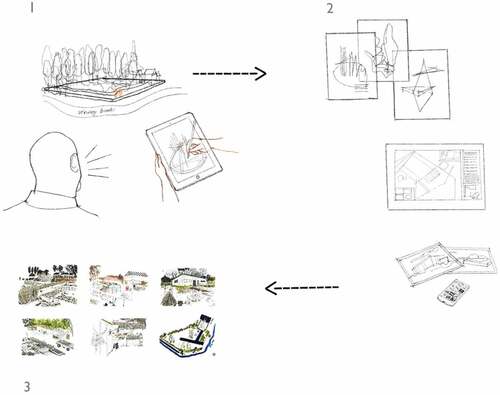
From the perspective of the research methodology, the process described above qualifies as naturalistic observational research due to it involving multiple angles—what, when, where, and how—all while allowing the observed behaviour or activity to flow naturally in its own environment. The output of the observation is an artefact (sketch) which differs markedly from a computer-generated visual; it does not necessarily offer a factual representation of the space observed, but one which serves as a conversation piece. The sketch is immediate and serves the purpose of a “mind diagram” which further incites dialogue about the space and regenerate as a new idea; the computer, however, is accurate, yet simple-minded (Petherbridge, 2002 as cited in Burch, Citation2014). The final illustrations as shown in show the output of the exercise. The illustrations are deemed as final, yet they are loose and sufficiently open to interpretation to leave room for imagination and speculation. As opposed to computer-generated imagery, the artistic nature of these visuals serves as an intermediary between the aspired outcome and realism. The visual output for the Cleavley Community Forest Garden, in this case, has enabled a non-traditional methodology to contextualise an intended outcome for the site in question. By using an artist as a channel for communicating radical interventions, the project has, in effect, facilitated the development of a narrative which can be drawn upon when discussing the scope—but also the limitations—of the site. As such, the practice used here is an illustration of Relational Aesthetics where the artist is not just a producer of visuals for the end user, but a facilitator (Bourriaud, Citation1998).
Figure 3. Illustration of aerial view overlooking the visitor centre (top) and the community growing raised beds. (Source: Adelina Court, 2019).
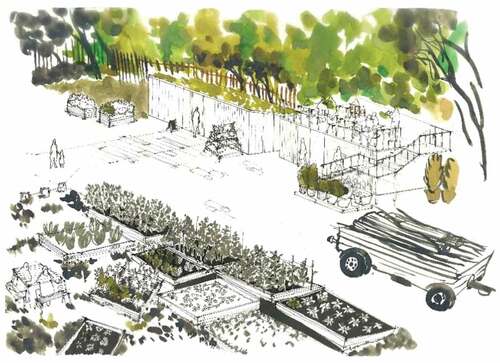
Figure 5. Illustration of the visitor and garden centre (foreground) and the community growing raised beds with car park immediately behind. (Source: Adelina Court, 2019).
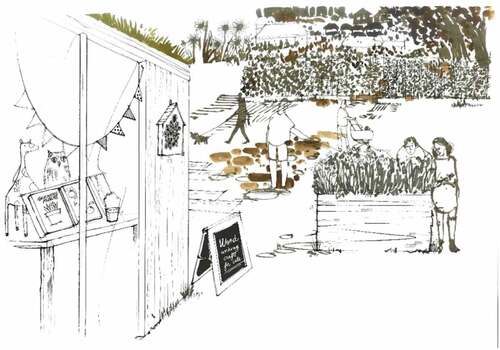
Figure 9. Illustration of the site map showing the location of the proposed areas of the scheme. (Source: Adelina Court, 2019).

We argue that this co-produced approach and visual tools enabling the upscaled urban farming model to be data-driven and allowed the project lead to convey the complexity of the concept with ease. The approach allowed for the project to convey their views of the site and potential; adjusting these considering the evidence presented to them around the need for multifunctionality and other assets to ensure sustainability. Visual methods are powerful tools which have been used in geography for some time, yet there is an opportunity space to upscale these and use them more explicitly on such research projects; in this sense, allowing direct benefits for the research subjects and their aim to create a sustainable urban farming model.
Such creative approaches can be used to further enable the broader UA movement, particularly in the post-COVID environment in which so much funding, policy tools and general focus is placed on the practice. Yet, a large barrier exists due to the often blank canvases and difficulty to convey the complex array of activities involved on the site; in this sense, we present one way, beyond computer simulation and architectural drawings, to produce a research-informed vision which can be used as a mechanism for generating funding and support. We now proceed to reflect on the impact of this work and demonstrate how this has enabled the rapid progress of the site.
9. Reflecting on progress
Follow-up visits in 2020, 2021, and 2022 demonstrate the rapid growth of the site and securing of funding from multiple sources. showcases the prominent nature of the visualisations created, with the UA space showcasing these at the entrance to all visitors. , from July 2022, shows the official opening of the larger space, with the Mayor of the city, the community and other key stakeholders in attendance. The site is now open all week, with an active café, social prescription scheme, a large volunteer base alongside paid employees, large-scale food growing and the forest school.
Figure 11. The official opening of the larger site, with the local community and key actors in attendance (Source: Incredible Education, 2022).
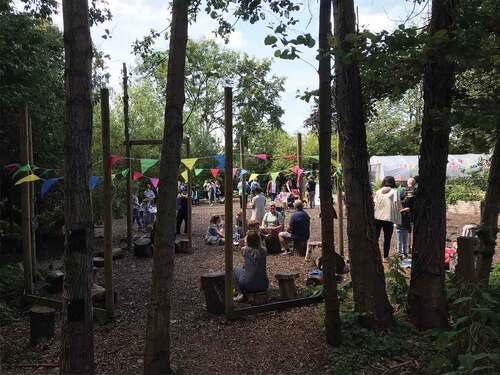
As highlighted in the earlier sections of this commentary piece, this case study provides evidence that UA can be implemented at a relatively large scale in a sustainable manner, particularly if a mosaic of complimentary activities is central to the business model. In this sense, the Incredible Education site shows how revenue can be generated through multiple assets and not merely food growing alone, allowing for a more resilient space overall. This connects well with thoughts from Caputo (Citation2012), Hardman et al. (Citation2022), Schoen et al. (Citation2020), Viljoen (Citation2005) and others, who argue that sustainable models are vital for a UA site to survive. The services at the Cleavley Community Forest Garden provides much needed access to fresh food to the local communities. As St Clair et al. (Citation2020) argue, UA can have the greatest impact in areas which rate poorly in terms of their fresh produce intake. In this case, the site is open to the public who can purchase fresh vegetables and fruit at discounted prices from the “Community Edible Garden” (Incredible Education, Citation2021).
Despite the success, there are still some barriers regarding the site’s sustainability. Core barriers surround long-term funding, land ownership, public participation, and issues around conflict with neighbours. Evidence shows that these barriers are shared more widely across the UA community, particularly the financial element (Caputo et al., Citation2020). If these radical sites are to be more commonplace in our urban environments, particularly with the rise in “green recovery” funds and other tools supporting their development, there is an urgent need for longer-term models that ensure financial sustainability. Projects should look to avoid relying on ad-hoc grant funding and instead, like this example, diversify activities to generate funding from social prescription, the selling of produce and other actions. Whilst there is a lot of promise for these innovative projects, barriers remain and there is a need for both projects and funders to understand these before proceeding. We argue that more research is required on the economic sustainability of the schemes whilst also raising attention about the enormous impact they can make in deprived areas.
10. Moving forwards
In this commentary paper, we have provided an overview of the appetite for UA, particularly in the post-COVID landscape. The paper also highlights the ever-increasing policy tools which are enabling the practice and appetite from funders, governments, and other key actors for UA. However, we have also highlighted the precarious nature of the practice and need for models which are more financially sustainable. Of particular note, we highlight a case study and exemplar of how researchers can work with projects to effectively enable the practice. Through using visual methods, we provide a framework for how researchers can co-produce spaces with urban farmers and help project leads to plan more efficiently. Ultimately, this could lead to more sustainable forms of the concept, which has significant social, environmental, and economic impacts on communities.
History shows that it is vital to plan such spaces and avoid a “top-down” approach. Failed large-scale examples in the UK, ranging from Wigan’s vertical farm to Salford’s Bisopheric Foundation project, evidence the need to connect with communities and create a space with social, environmental and economic value (see Blythe et al., Citation2021). The former was mooted to feed the homeless in the town and create new job opportunities in urban farming, whilst the latter aimed to reduce food miles in Salford; in both cases, the models employed resulted in the projects ceasing to operate after a few years. The Incredible Education model offers a case of how larger-scale UA can be implemented successfully and in collaboration with researchers, allowing the practice to flourish.
Alongside calling for more sustainable financial models for UA in this commentary piece, we also call for creative ways for researchers to work with establishing or maintaining these spaces. As interest grows, there is a crucial opportunity space to help convert more stalled or underused space into UA sites. As per our earlier comments, we provide one example here of how visual methods can be used to create a plan and obtain funding. However, good practice elsewhere also offers other opportunities: a key barrier to UA often surrounds soil conditions. Researchers at Washington State University’s Stable Isotope Lab regularly work with such spaces to provide soil sampling for free, allowing smaller- and medium-sized UA spaces to gain access to vital data (see, WSU, Citationn.d.). Through adopting such approaches, researchers can be powerful actors in helping the movement to continue to grow in the post-COVID environment; impacting significantly on urban communities and beyond.
Disclosure statement
No potential conflict of interest was reported by the authors.
Additional information
Funding
References
- Affolderbach, J., & Schulz, C. (2017). Positioning Vancouver through urban sustainability strategies? The greenest city 2020 action plan. Journal of Cleaner Production, 164, 676–17. https://doi.org/10.1016/j.jclepro.2017.06.234
- Al-Chalabi, M. (2015). Vertical farming: Skyscraper sustainability. Sustainable Cities and Society, 18(November), 74–77. https://doi.org/10.1016/j.scs.2015.06.003
- Bell, S., Fox-Kämper, R., Keshavarz, N., Benson, M., Caputo, S., Noori, S., & Voigt, A. (2016). Urban allotment gardens in Europe. Taylor and Francis.
- Bioaquafarm. (n.d.). The future of sustainable farming. https://bioaquafarm.co.uk/
- Blythe, C., Egginton-Metters, I., Hardman, M., & Schoen, V. (2021). The school farms network in the UK: History, context, and adding value. In A. A. Farag, S. Badawi, G. Lalli, & M. Kamareddine (Eds.), School farms: Educating and feeding children (pp. 67–82). Routledge.
- Blythe, C., & Schoen, V. (2020) A growing opportunity for community gardens in London. RUAF. https://ruaf.org/news/covid-19-a-growing-opportunity-for-community-gardening-in-london/
- Bourriaud, N. (1998). Relational aesthetics. Les Presse du Reel.
- Bulkeley, H., Castan Broto, V., Hodson, M., & Marvin, S. (2011). Cities and the low carbon transitions. Routledge.
- Burch, J. (2014). Architectural drawing: The culture of learning an unstable currency. Charrette, 1(1), 20–35.
- CAFF. (2020). Community Alliance with Family Farmers. https://www.caff.org/about/
- Cappelli, A., & Cini, E. (2020). Will the COVID-19 pandemic make us reconsider the relevance of short food supply chains and local productions? Trends in Food Science & Technology, 99, 566–567. https://doi.org/10.1016/j.tifs.2020.03.041
- Caputo, S. (2012). The Purpose of Urban Food Production in Developed Countries. In A. Viljoen, J. S. C. Wiskerke (Eds.), Sustainable Food Planning: Evolving Theory and Practice. Wageningen, The Netherlands: Wageningen Academic Publishers.
- Caputo, S., Rumble, H., & Schaefer, M. (2020). “I like to get my hands stuck in the soil”: A pilot study in the acceptance of soil-less methods of cultivation in community gardens. Journal of Cleaner Production, 258, 1–11. https://doi.org/10.1016/j.jclepro.2020.120585
- Carrot City. (n.d.). Designing for urban agriculture. www.carrotcity.org
- Castree, N. (2005). Nature. Routledge.
- Certoma, C., & Tornaghi, C. (Eds.). (2019). Urban gardening as politics. Routledge.
- Chipungu, L., Magidimisha, H., Hardman, M., & Beesley, L., (2015). Exploring urban agriculture in Africa: A review of the practice in Harare. Nairobi and Johannesburg. CABI Books.
- Collie, N. (2013). Walking in the city: Urban space, stories, and gender. Gender Forum, 1–5.
- CoVeg. (2020). CoVeg – Growing Vegetables in the Community, with the Community. https://www.coveg.co.uk
- Duncan, J. S. (1990). The city as text: The politics of landscape interpretation in the Kandyan Kingdom. Cambridge University Press.
- Elliot, B. (2018). Urban agriculture, uneven development and gentrification in Portland, Oregon. Environmental Ethics, 40(2), 173–183. https://doi.org/10.5840/enviroethics201840216
- Farm Urban. (n.d.). Aquaponics in Liverpool. https://farmurban.co.uk/
- Galanakis, C. M. (2020). The food systems in the era of the coronavirus (COVID-19) pandemic crisis. Foods, 9(4), 523. https://doi.org/10.3390/foods9040523
- Greater London Authority. (2020). Mayor’s bold new Streetspace plan will overhaul London’s streets. https://www.london.gov.uk/press-releases/mayoral/mayors-bold-plan-will-overhaul-capitals-streets
- Hardman, M., Chipungu, L., Hangwelani, M., Larkham, P. J., Scott, A. J., & Armitage, R. P. (2018). Guerrilla gardening and green activism: Rethinking the informal urban growing movement. Landscape and Urban Planning, 170, 6–14. https://doi.org/10.1016/j.landurbplan.2017.08.015
- Hardman, M., Chipungu, L., Hangwelani, M., Larkham, P. J., Scott, A. J., & Armitage, R. P. (2018). Guerrilla Gardening and Green Activism: Rethinking the Informal Urban Growing Movement. Landscape and Urban Planning, 170( 55), 6–14.
- Hardman, M., Clark, P., & Sherriff, G. (2022). Mainstreaming Urban Agriculture. Agronomy, 12(3), 601–616.
- Heath, S., Chapman, L., & Centre Sketchers, T. M., & The Morgan Centre Sketchers. (2018). Observational sketching as method. International Journal of Social Research Methodology, 21(6), 713–728. https://doi.org/10.1080/13645579.2018.1484990
- Holland, L. (2004). Diversity and Connections in Community Gardens: A Contribution to Local Sustainability. Local Environment: The International Journal of Justice and Sustainability, 9(3), 285–305.
- Howarth, M. L., Brettle, A. J., Hardman, M., & Maden, M. (2020). What is the evidence for the impact of gardens and gardening on health and wellbeing: A scoping review and evidence-based logic model to guide healthcare strategy decision making on the use of gardening approaches as a social prescription. BMJ Open, 10(7), e036923. https://doi.org/10.1136/bmjopen-2020-036923
- Hubbard, P. (2006). City. Routledge.
- Hydroponics Society of America. (n.d.). Hydroponics in the USA. http://www.hydroponicsocietyofamerica.org/
- Incredible Edible. (2019). Incredible edible network. https://www.incredibleedible.org.uk
- Incredible Education. (2021). Cleavley Community Forest Garden. https://www.incredibleeducation.co.uk/ccfg
- Ingold, T. (2011a). Being alive: Essays on movement, knowledge and description. Routledge.
- Ioannou, B., Moran, N., Sondermann, M., Certoma, C., Hardman, M., Anthopoulou, T., Notteboom, B., & Silverstri, G. (2016). Grassroots gardening movements: Towards cooperative forms of green urban development? In S. Bell, R. Fox-Kamper, N. Keshavarz, M. Benson, S. Caputo, S. Noori, & A. Voigt (Eds.), Urban allotment gardens in European cities (pp. 62). Routledge.
- Jensen, O. B. (2007). Culture Stories: Understanding Cultural Urban Branding. Planning theory (London. England), 6(3), 211–236. https://doi.org/10.1177/1473095207082032
- Khan, S., Siddique, R., Li, H., & Ali, A., Shereen, M. A., Bashir, N., & Xue, M. (2020). Impact of coronavirus outbreak on psychological health. Journal of Global Health, 10(1), 010331. https://doi.org/10.7189/jogh.10.010331
- Localism Act. (2011). Localism Act. Retrieved from: https://www.legislation.gov.uk/ukpga/2011/20/contents/enacted
- LS:N Global. (2019). Thought-starter: Will rooftop farms feed the masses? https://www-lsnglobal-com.salford.idm.oclc.org/news/article/23728/thought-starter-will-rooftop-farms-feed-the-masses
- Madanipour, A., Knierbein, S., & Degros, A. (2014). Public space and the challenges of urban transformation in Europe. Routledge.
- Mitchell, L., Houstin, L., Hardman, M., Cook, P., & Howarth, M. L. (2021). Enabling urban social farming: The need for radical green infrastructure in the city. Cogent Social Sciences, 7(1), 1–15. https://doi.org/10.1080/23311886.2021.1976481
- National Planning Policy Framework. (2021). NPPF. Retrieved from: https://assets.publishing.service.gov.uk/government/uploads/system/uploads/attachment_data/file/1005759/NPPF_July_2021.pdf
- Natter, W., & Jones III, J.P. (1997). Identity, Space and Other Uncertainties. Space and Social Theory, Interpreting Modernity and Postmodernity, 141–161.
- Ostlere, L. (2020). Coronavirus: Should we be cycling during lockdown and is it safer than ever? Independent. https://www.independent.co.uk/
- Perambalam, L., Avgoustaki, D. D., Efthimiadou, A., Liu, Y., Wang, Y., Ren, M., & Xydis, G. (2021). How Young Consumers Perceive Vertical Farming in the Nordics. Is the Market Ready for the Coming Boom? Agronomy, 11(11), 2128.
- Reuters. (2021) COVID-19 pandemic puts Barcelona urban greening plan in fast plan. https://www.reuters.com/article/us-spain-coronavirus-city-environment-fe-idUSKBN29G0I2
- The Royal Horticultural Society. (2020). Set up a community garden. https://www.rhs.org.uk/get-involved/community-gardening/resources/community-garden
- Salford City Council. (2019). Ward Profiles. Retrieved August 20, 2020, from https://www.salford.gov.uk/people-communities-and-local-information/my-local-community/ward-profiles/
- Schoen, V., Caputo, S., & Blythe, C. (2020). Valuing physical and social output: A rapid assessment of a London community garden. Sustainability, 12(13), 1–20. https://doi.org/10.3390/su12135452
- Sherwood, H. (2020). Coronavirus cycling boom makes a good bike hard to find. The Guardian. https://www.theguardian.com/
- Social Farms & Gardens. (2018). About us. https://www.farmgarden.org.uk/about-us
- St Clair, R., Hardman, M., Armitage, R. P., & Sheriff, G. S. (2017). The trouble with temporary: Impacts and pitfalls of meanwhile community gardening in wythenshawe. Agronomy. https://doi.org/10.1017/S1742170517000291
- St Clair, R., Hardman, M., Armitage, R. P., & Sheriff, G. S. (2017). The Trouble with Temporary: Impacts and Pitfalls of Meanwhile Community Gardening in Wythenshawe. South Manchester. https://doi.org/10.1017/S1742170517000291
- St Clair, R., Hardman, M., Armitage, R. P., & Sheriff, G. S. (2020). Urban agriculture in shared spaces: The difficulties with collaboration in an age of austerity. Urban Studies, 57(2), 350–365. https://doi.org/10.1177/0042098019832486
- Sustainable Food Places. (n.d.). Current sustainable food places award winners. https://www.sustainablefoodplaces.org/awards/awardwinners/
- Sustainweb. (2020). UK Nature Friendly Farmers Responding To COVID-19 And Call For People To Support Local, Seasonal Produce. https://www.sustainweb.org/news/apr20_nature_friendly_food_solutions/
- Transport for Greater Manchester. (2020). Leaders progress bold active travel plans as up to £5m of emergency funding made available as part of coronavirus recovery. https://news.tfgm.com/news/leaders-progress-bold-active-travel-plans-as-up-to-gbp-5m-of-emergency-funding-made-available-as-part-of-coronavirus-recovery
- United Nations. (2017). Population. https://www.un.org/en/global-issues/population
- Viljoen, A. (2005). Continous Productive Urban Landscapes. Routledge.
- Vinebrooke, R. D., Cottingham, K. L., Norberg, J., Dodson, S. I., Maberly, S. C., & Sommer, U. (2004). Impacts of multiple stressors on biodiversity and ecosystem functioning: The role of species co-tolerance. Oikos, 104(3), 451–457. https://doi.org/10.1111/j.0030-1299.2004.13255.x
- Vogel, L. (2020). What’s next now that the WHO has declared a COVID-19 pandemic? Canadian Medical Association Journal, 192(13), 349–350. https://doi.org/10.1503/cmaj.1095855
- Woodman, E. (2015). Bosco verticale by stefano boeri architetti. The Architects’ Journal. https://search-proquest-com.salford.idm.oclc.org/docview/1658785391?accountid=8058
- WSU. (n.d.). Stable isotope core laboratory. https://labs.wsu.edu/isotopecore/
- Yes!. (2020). COVID-19 sparks a rebirth of the local farm movement. https://www.yesmagazine.org/environment/2020/05/21/coronavirus-food-local-farm-movement/?fbclid=IwAR1-Ys7sjXvjicPehPfi4WrpWH0Pe-ae3jfGw_qO6xAY2Zs7CgACzYgjmkg

